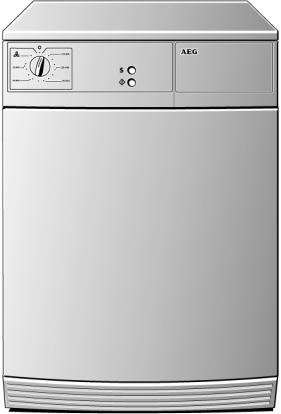AEG LAVATHERM T30 User Manual

LAVATHERM T30
Vented Tumble Dryer
Operating Instructions

|
Dear customer, |
|
Please read these operating instructions through carefully, before using |
|
the appliance. |
|
Please ensure you fully understand the safety instructions on the first |
|
pages of these operating instructions! Retain this instruction book for |
|
future reference, and pass on to any future owners. |
1 |
The warning triangle and/or the key words (Warning!, Caution!, |
|
Important!), emphasize information which is important for your safety |
|
or the correct functioning of the appliance. It is essential that this |
|
information is observed. |
0 This symbol guides you step by step when operating the appliance. |
|
3 |
This symbol gives additional information and practical tips on using the |
|
appliance. |
2 |
Tips and information about the economical and environmentally |
|
friendly use of the machine are marked with the clover symbol. |
These operating instructions contain information about how to independently solve any problems which may arise. See "Something not working?".
Printed on environmentally friendly paper ...
Whoever thinks ecologically also acts ecologically.
2

Content |
|
Important Safety Information . . . . . . . . . . . . . . . . . . . . . . . . . . . . . . . . . . . . |
5 |
General Information . . . . . . . . . . . . . . . . . . . . . . . . . . . . . . . . . . . . . . . . . . . . |
8 |
Disposal . . . . . . . . . . . . . . . . . . . . . . . . . . . . . . . . . . . . . . . . . . . . . . . . . . . . . . . |
9 |
Packaging . . . . . . . . . . . . . . . . . . . . . . . . . . . . . . . . . . . . . . . . . . . . . . . . . . . . . . |
9 |
Environmental protection tips . . . . . . . . . . . . . . . . . . . . . . . . . . . . . . . . . . . |
10 |
Description of the appliance . . . . . . . . . . . . . . . . . . . . . . . . . . . . . . . . . . . . . |
12 |
Front view . . . . . . . . . . . . . . . . . . . . . . . . . . . . . . . . . . . . . . . . . . . . . . . . . . . . . . |
12 |
Control panel . . . . . . . . . . . . . . . . . . . . . . . . . . . . . . . . . . . . . . . . . . . . . . . . . . . |
13 |
The program selector positions . . . . . . . . . . . . . . . . . . . . . . . . . . . . . . . . . . . . |
14 |
Program selector as progress indicator . . . . . . . . . . . . . . . . . . . . . . . . . . . . . . |
14 |
Before using the appliance for the first time . . . . . . . . . . . . . . . . . . . . . . |
14 |
Brief operating instructions . . . . . . . . . . . . . . . . . . . . . . . . . . . . . . . . . . . . . |
15 |
Drying . . . . . . . . . . . . . . . . . . . . . . . . . . . . . . . . . . . . . . . . . . . . . . . . . . . . . . . . . |
16 |
Prepare the laundry . . . . . . . . . . . . . . . . . . . . . . . . . . . . . . . . . . . . . . . . . . . . . . |
16 |
Open the door . . . . . . . . . . . . . . . . . . . . . . . . . . . . . . . . . . . . . . . . . . . . . . . . . . |
16 |
Load the laundry . . . . . . . . . . . . . . . . . . . . . . . . . . . . . . . . . . . . . . . . . . . . . . . . |
16 |
Select the drying program . . . . . . . . . . . . . . . . . . . . . . . . . . . . . . . . . . . . . . . . |
16 |
Removing laundry or loading laundry when necessary . . . . . . . . . . . . . . . . . |
18 |
End of the drying process . . . . . . . . . . . . . . . . . . . . . . . . . . . . . . . . . . . . . . . . . |
18 |
Removing the laundry . . . . . . . . . . . . . . . . . . . . . . . . . . . . . . . . . . . . . . . . . . . . |
18 |
Switch-off the dryer . . . . . . . . . . . . . . . . . . . . . . . . . . . . . . . . . . . . . . . . . . . . . |
18 |
Clean the fluff filter . . . . . . . . . . . . . . . . . . . . . . . . . . . . . . . . . . . . . . . . . . . . . |
19 |
Program tables . . . . . . . . . . . . . . . . . . . . . . . . . . . . . . . . . . . . . . . . . . . . . . . . . |
20 |
A small glossary of textile information . . . . . . . . . . . . . . . . . . . . . . . . . . . . |
21 |
Care symbols . . . . . . . . . . . . . . . . . . . . . . . . . . . . . . . . . . . . . . . . . . . . . . . . . . . |
21 |
Cleaning and maintenance . . . . . . . . . . . . . . . . . . . . . . . . . . . . . . . . . . . . . . |
22 |
Cleaning the filter area . . . . . . . . . . . . . . . . . . . . . . . . . . . . . . . . . . . . . . . . . . . |
22 |
Cleaning the drum . . . . . . . . . . . . . . . . . . . . . . . . . . . . . . . . . . . . . . . . . . . . . . . |
22 |
Cleaning the panel and operating parts . . . . . . . . . . . . . . . . . . . . . . . . . . . . . |
22 |
3

Content
Something not working? . . . . . . . . . . . . . . . . . . . . . . . . . . . . . . . . . . . . . . . . |
23 |
Door Reversal Instructions . . . . . . . . . . . . . . . . . . . . . . . . . . . . . . . . . . . . . . . |
24 |
Technical data . . . . . . . . . . . . . . . . . . . . . . . . . . . . . . . . . . . . . . . . . . . . . . . . . |
26 |
Power supply . . . . . . . . . . . . . . . . . . . . . . . . . . . . . . . . . . . . . . . . . . . . . . . . . . . |
26 |
Information for the electrician . . . . . . . . . . . . . . . . . . . . . . . . . . . . . . . . . . . |
26 |
Special accessories . . . . . . . . . . . . . . . . . . . . . . . . . . . . . . . . . . . . . . . . . . . . . . |
27 |
Stacking kit . . . . . . . . . . . . . . . . . . . . . . . . . . . . . . . . . . . . . . . . . . . . . . . . . . . . |
27 |
Vent hose . . . . . . . . . . . . . . . . . . . . . . . . . . . . . . . . . . . . . . . . . . . . . . . . . . . . . . |
27 |
Index . . . . . . . . . . . . . . . . . . . . . . . . . . . . . . . . . . . . . . . . . . . . . . . . . . . . . . . . . . 28
Service . . . . . . . . . . . . . . . . . . . . . . . . . . . . . . . . . . . . . . . . . . . . . . . . . . . . . . . . 31
4

Important Safety Information
1Important Safety Information
The safety of AEG electrical appliances complies with the established technical principles and statutory equipment safety regulations. Nevertheless, as manufacturer we have to draw your attention to the following safety instructions.
General safety
•Repairs of the dryer may be carried out only by trained personnel. Incompetently carried out repairs can entail considerable hazards for the user. Please get in touch with our customer service or with an authorised AEG dealer when repair is necessary.
•Before commencing operation please make sure that the nominal voltage and type of supply specified on the type plate of the appliance correspond to the actual nominal voltage and supply type at the place of utilisation. The fuse rating is also specified on the type plate.
•Never operate the dryer when the mains cable is damaged or when the operator control mask, work plate or base shrouding are damaged such that there is direct access to the interior of the appliance.
•Switch-off the dryer before carrying out any cleaning, care and maintenance tasks! You are quite safe if you disconnect the mains plug from the power outlet or – if the electrical connection is permanent – if you switch-off the circuit breaker in the fusebox or screw the fuse cartridge right out of its holder.
•Never pull on the cable to disconnect the mains plug from the power outlet. Always grasp and pull-out the plug.
•Don’t lean on the opened door; this could make the appliance fall over.
•Don’t use a water jet to spray-down the appliance. Danger of electric shock!
•If you interrupt the drying process to take out laundry, bear in mind that the laundry and the drum could be hot.
•Adaptors and extension cables must not be used. There is risk of fire because of overheating!
5

Important Safety Information
Safety of children
•Children are often not aware of the dangers involved when handling electrical equipment. Therefore provide the necessary supervision of children when operating the appliance and do not let children play with the dryer – there is a danger that children could become trapped inside the appliance.
•Packaging parts (e.g. films, styropore) can be dangerous for children. Danger of suffocation! Keep packaging parts out of reach of children.
•Make sure that children or small animals do not climb into the drum of the dryer. For this purpose keep the door of the dryer closed when the appliance is not in use.
Utilisation in accordance with the intended purpose
•Conversions or modifications of the dryer are forbidden for safety reasons.
•Use the dryer only to dry ordinary household laundry! The manufacturer accepts no liability for any damage resulting from incorrect operation or utilisation for an unintended purpose.
•Dry only laundry which has been washed in water. In particular, textiles which have been treated with inflammable cleaning agents and solvents (petrol-ether, alcohol, stain remover and similar materials) must not be dried in the dryer. Danger of fire! Explosion hazard!
•Laundry items containing sponge rubber or rubber-like materials must not be dried in the dryer. Danger of fire!
•Washing that is in poor condition (heavily worn) and items with loose fillings (cushions) that could break open must not be dried or aired. There is a risk of fire!
•Washing with rigid components (foot mats) will cover the air slots; the slots will also be covered if the drum is overfilled. Observe the maximum load of 5 kg. There is a risk of overheating which could cause a fire!
•Only dry washing that does not contain any explosive objects (fire lighters, spray cans). There is a risk of fire or an explosion!
•In the case of washer / dryer tower combinations, do not place any objects on the dryer during use as they could drop down.
6

Important Safety Information
Installation and connection
•Please follow the separate Installation and connection instructions. If necessary get some advice from your local chimney sweep or building authorities.
•If the tumble dryer has to be carried, first remove the base strip!
•Check the tumble dryer fortransport damages. Under no circumstances should you connect a damaged appliance! Please contact your supplier in the event of damages.
•Do not install the tumble dryer in rooms which are in danger of freezing!
•Install the tumble dryer level!
•When installed next to a gas, coal or electric heater: a heat insulating, non-flammable board must be inserted (dimensions: 85x57.5 cm).
•The plug of the appliance must be freely accessible after installation.
•The outgoing air from the tumble dryer may not be led into a smoke or chimney flute.
•Do not lead the outgoing air into a shaft which serves to ventilate rooms in which heating is installed.
•Do not install the tumble dryer in a room in which heaters with coal and oil connected to a chimney are located in which the under pressure is 0.04mbar or more.
•Provide sufficient ventilation to avoid underpressure from forming.
•In accordance with the technical connection conditions of the power utilities, a permanent connection to the power supply may only be made by an authorised electrician.
•The dryer sucks in air. You should therefore keep the area around the appliance clean and also not store any flammable items that may be sucked into the appliance (e.g. cat litter, shavings) in front of it. There is risk of fire!
7

General Information
3General Information
•Starched washing leaves traces of starch on the drum and therefore should not be placed in the tumble dryer.
•If you exceed the maximum load stipulated in the program table your washing is more likely to get creased! For very delicate fabrics you should only fill in 1.5kg washing at the most.
•When using so-called "fabric conditioner sheets", a deposit on the fluff filter may result, which can cause a blockage. We therefore recommend not using fabric conditioner sheets.
•For your information: 70 per cent of fabric wear is caused by being worn, 20 per cent by washing and only 10 per cent by being dried in a tumble dryer. As the fabric is worn down, fluff gathers in the fluff filter. When using a tumble dryer, only approx. 0.03g fluff per kilogramme washing is produced.
8

Disposal
2Disposal
Packaging
Dispose of the packaging material!
Dispose of the packaging material of your tumble dryer correctly. All the packaging materials used are harmless to the environment and can be recycled.
• Plastic parts are marked with standard international abbreviations:
– >PE< |
for polyethylene, e.g. sheet wrapping material |
– >PS< |
for polystyrene, e.g. padding material (always CFC-free) |
– >POM< |
for polyoxymethylene, e.g. plastic clips |
Cardboard packaging is manufactured from recycled paper and should be deposited in the waste paper collection for recycling.
Disposal of the old appliance!
When you eventually stop using your tumble dryer please bring it to the nearest recycling centre or to your dealer who will take it back for a small fee.
1 Warning! When disposing of the tumble dryer, pull out the plug, cut off the flex, dispose of the plug and remaining flex and destroy the door lock. This hinders children from locking themselves in and endangering their lives.
The materials can be recycled in accordance with their markings. Standard tools (crosshead screwdriver, hammer) are sufficient to dismantle the old appliance.
9

Environmental protection tips
2 Environmental protection tips
•Your laundry will become light and soft in the tumble dryer even without a fabric softening agent.
•Loosen your laundry before loading it into the dryer. This helps to prevent lengthy running times and creasing. Ensure your laundry is well spun.
In the following table we give an overview of specific electric consumption data depending on the spinning speed. This information is valid for 5kg laundry.
Spinning/wringing out: |
|
Drying cycle: |
||||
Revolutions per |
Residual dampness |
Time required in |
Energy requirement |
|||
|
|
|
||||
minute |
in litres |
|
in % |
minutes |
in kWh |
|
|
|
|
|
|||
800 |
3.5 |
|
70 |
80 |
3.3 |
|
1000 |
3.0 |
|
59 |
75 |
2,8 |
|
1200 |
2.7 |
|
53 |
70 |
2.5 |
|
1400 |
2.5 |
|
50 |
65 |
2.3 |
|
1600 |
2.4 |
|
47 |
60 |
2.2 |
|
|
|
|
|
|
|
|
•Observe the maximum load instructions. Whenever possible, dry full loads.
10
